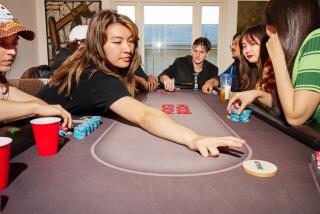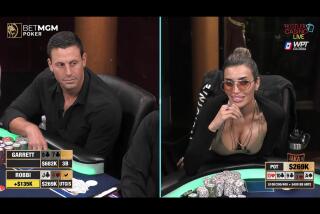With connectors, suit yourself
- Share via
Ever since Doyle Brunson wrote about the value of suited connectors in his seminal poker tome “Super/System” more than 30 years ago, people have played them as if they were pocket aces.
But even when you have position and a narrowed range of your opponent’s holdings, you have to know your limits, as aggressive pro Mark Seif figured out at, appropriately, the $15,000-buy-in Doyle Brunson Five Diamond World Poker Classic at Las Vegas’ Bellagio in 2008.
With blinds at $50-$100, Seif found 10-9 of clubs on the button and called a raise to $350 from the player to his right.
“I have the best position throughout the hand after the flop,” said Seif, winner of two World Series of Poker bracelets.
“The hand has a lot of potential, and I can get away from it if it misses. Plus, he raised, so it narrows his range of hands to something fairly big.”
The flop came Q-10-9, two hearts, giving Seif bottom two pair.
“If you call with suited connectors, you’d better have a big draw or flop at least two pair,” Seif said. “Even if it’s bottom two pair, you’re beating aces.”
His opponent checked. Seif bet $700. His opponent check-raised to $2,200.
“The amount doesn’t tell me anything except he probably has at least a legit pair,” said Seif, an instructor for the World Series of Poker Academy. “But legit is what? Aces? Kings? A-Q?”
Seif called. The turn came the 2 of hearts, completing a potential flush. The initial raiser checked again.
“It slowed my opponent down because he thinks I could’ve called with a heart draw,” Seif said. “I didn’t want to give a free card because I didn’t have a heart in my hand. I wanted to bet it in case some goofy card like a jack, king or 8 came on the end. Then I’d really hate my hand.”
Seif made it $3,200, which could look like a value bet.
“It’s also a blocking bet,” Seif said. “It’s intended for him to call and check the river to me so I can check behind him.”
His opponent called. The river came the 5 of spades. Seif got what he wanted when his opponent checked. But after Seif checked behind, his opponent showed Q-10 of diamonds for a higher two pair.
It looked as if Seif missed a bet on the end that might’ve won the pot. But he believes he saved himself some chips based on his image.
“I have this reputation of bluffing and overvaluing my hand and putting too many chips in when I shouldn’t be,” Seif said. “I have to take into consideration what they think I have and how they’re going to play me. The fact is, I have to bluff less. My strength comes from having a big hand and them paying me off. He’s not laying down top two pair to me in that situation.”
Table talk
Check-raise: To pass on a betting opportunity as a way of showing weakness, only to raise an opponent’s bet in the same round as a show of strength.


